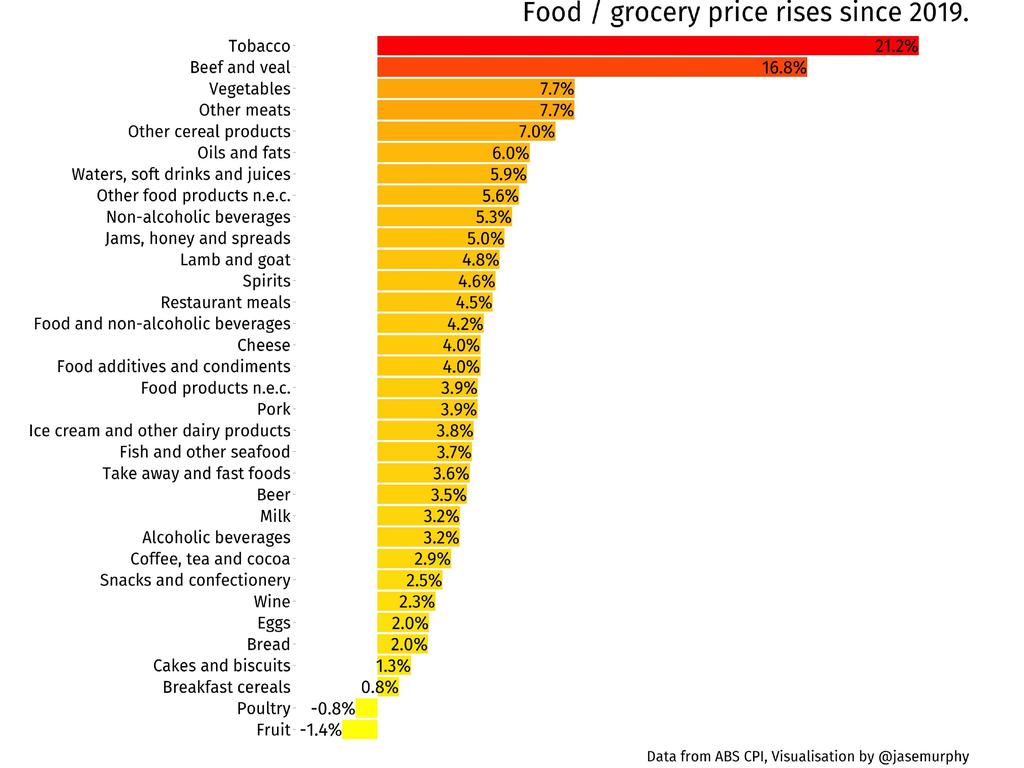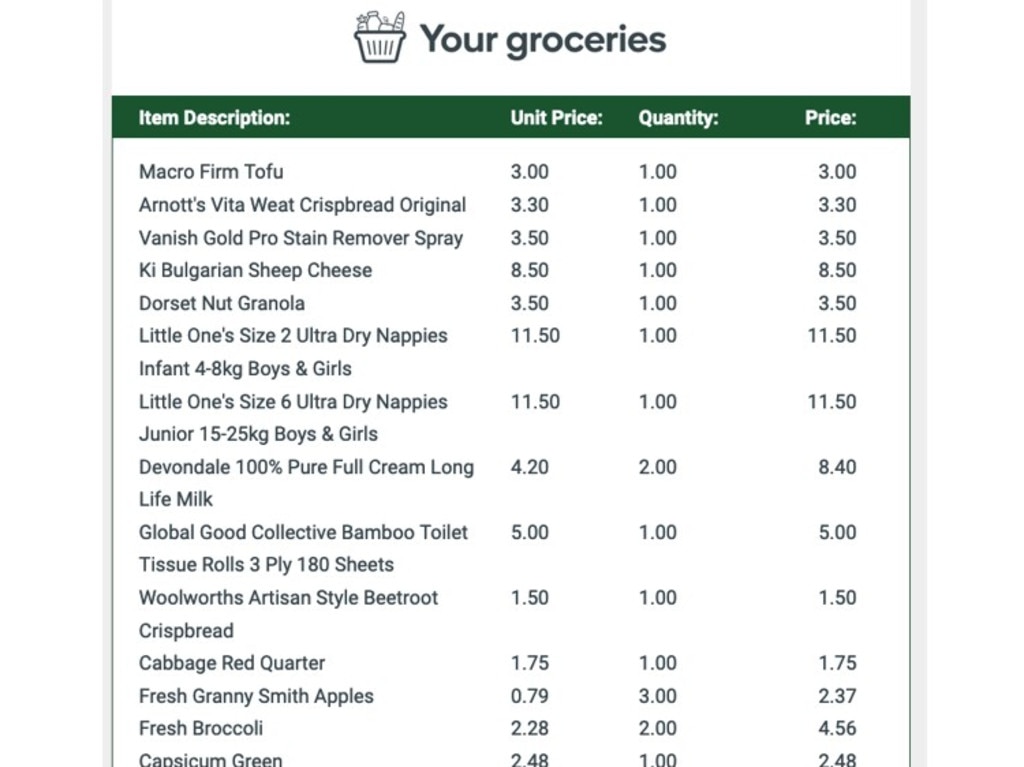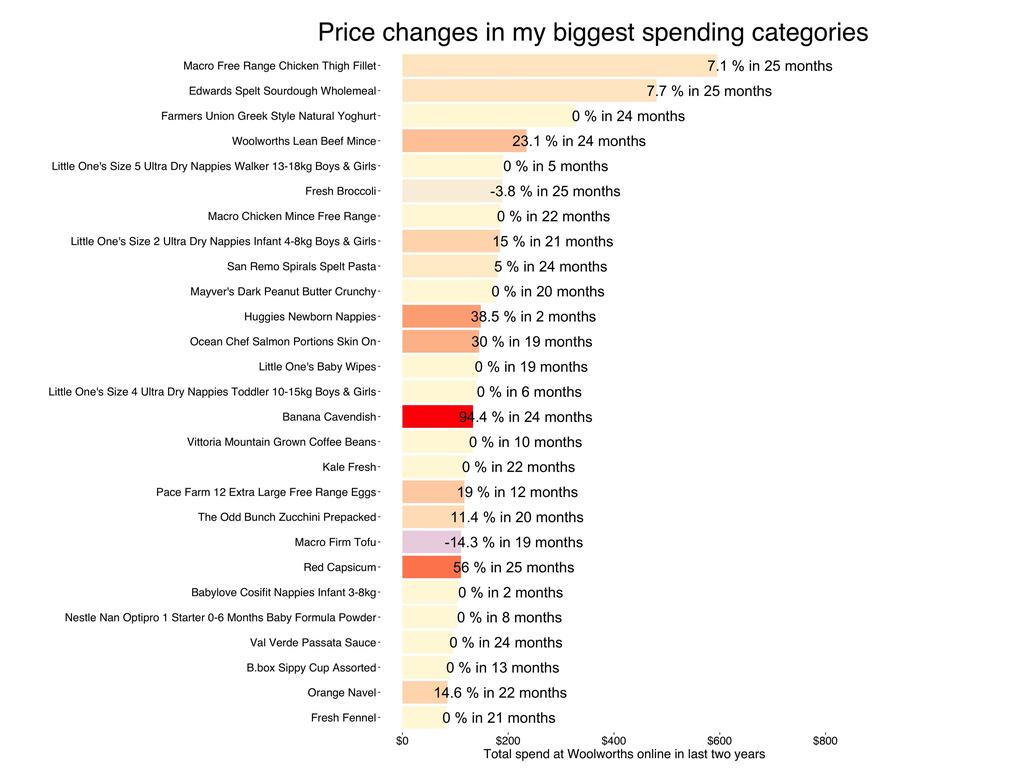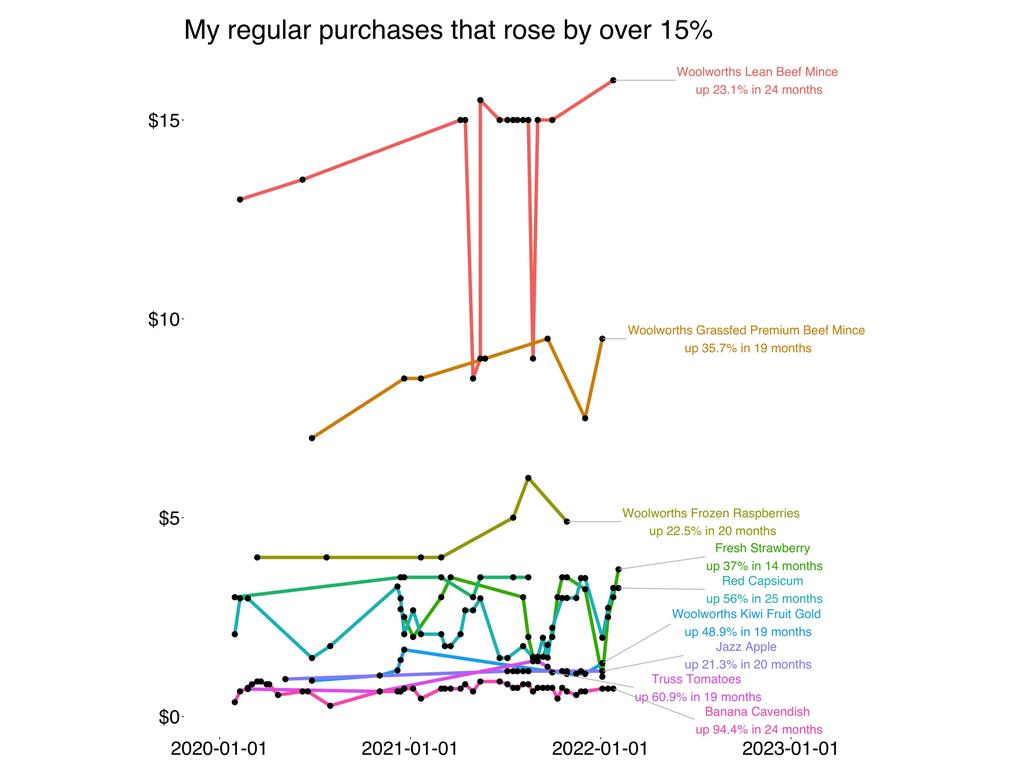Woolworths receipts investigation reveals real food price increase
A deep-dive into an average supermarket shop has unveiled a big problem facing everyday Aussies – but how bad is it going to get?

Everyone is talking about grocery prices. They’re up. The totals we’re seeing at the checkout are higher than ever before. But by how much?
Official data says groceries have risen by 4.2 per cent between December 2019 and December 2021, excluding tobacco and alcohol. That’s a touch slower than overall consumer price inflation which has gone up 4.39 per cent in total over two years.
But that’s not what I’m hearing. People feel like their grocery bills have gone up far, far more than the official figures. The word inflation literally means price rises. So the Consumer Price Inflation index is supposed to represent price changes exactly. Does it?
I talk to a lot of people who think the inflation data is wrong. Some people think it’s an error. Some people think it’s a conspiracy.
The Bureau of Statistics goes to a lot of trouble to make sure the CPI basket represents what the average person buys. They pay attention to packet size and adjust price changes for changes in package size, etc. They’re very professional, and they are independent of the RBA, which sets interest rates. They should be getting it right.
Here’s what they are seeing in the last two years.
Stream more finance news live & on demand with Flash, a dedicated news streaming service. New to Flash? Try 14 days free now >

Of course, the overall CPI is an average. It covers average purchases for the average person. It includes some things that went up, some things that stayed stable. But we are all unique. If you spend a lot on chicken and Weet-Bix and fruit, your personal experience of inflation is probably low. If you spend a lot on beef and vegetables and cigarettes, well, you’re in the other situation.
Skyrocketing cost of living
Last week an extremely popular online post was brought to my attention. A person posting on Reddit claimed their grocery bill was “skyrocketing”.
“I feel like I’m losing my mind,” the person said. “In the last 1.5 years, after buying the EXACT same things every week, my total bill has risen at least 25%, closer to 40% for some products … I am literally getting poorer for doing living the exact same way.”
Is this really possible, I wondered? The official statistics say it is much less. The person did not bring any actual numbers to the discussion. Could they be forgetting how much groceries used to cost? Maybe. Or maybe, I said to myself, I rely too much on the official statistics. I should check against reality. So I set out to see what was real.
Reality check
I mostly buy my groceries online from Woolworths, and that means I have a whole lot of receipts on my computer. I decided to get out all the receipts since the start of 2020, and sure enough I’m spending more now.

As the next graph shows, back in 2020 I did several online shops that cost about $160. Back then, I spent under $200 about a third of the time. But my last five shops have all been over $250. What’s going on? Is this evidence prices are going up? Or is it something else?

Do I spend too much on groceries? It does seem like a lot.
Part of the answer is I’m buying more. Pre-pandemic I used to go to Aldi about once a month and stock up on long-lasting goods – tinned food, cheese, etc. Now I buy almost everything from Woolies. The number of items I put in my trolley has gone up from about 45 to nearly 60. Partly this is because we are eating at home more. But we also had two kids during the pandemic, which is definitely affecting how much I buy!
Still, people buying more items is consistent with what Woolworths themselves have said. In their most recent sales update they said they are seeing “items per basket” up by 10 per cent (Although that was a while ago – covering the period July, August, September 2021).
Is that the full explanation? It’s time to look at some actual prices.
Here’s a graph showing my big ticket items, ones I spent at least $80 on over the last two years, ranked by how much I spent.

A lot of them have gone up – my top five items includes three that have risen, none that have fallen. In this list, only two items have gone down in price across my experience of buying them: tofu and broccoli.
These are the price changes that matter most, because they are in the categories I spend most on. About half the items haven’t changed in price. But there’s some whopping big rises in there that are affecting my grocery bill.
The price changes above are taken from my actual shopping receipts, so they are not all the same time periods. I’ve made that clear in the chart – some compare a price from early 2020 to now, others are comparisons over shorter periods. The per cent change compares the first time I bought the item to the most recent time, not an annual change – so be careful comparing it to inflation.
Another reason to take all this with a grain of salt is that if prices go up a lot I may stop buying the item! I’m certainly eating a bit less beef now.
Here’s some of the things that have risen the most. These are things I’ve bought despite the price rise. What you will notice is they are mostly healthy food – I think that’s why inflation hurts so much, because it’s in the fresh, healthy stuff – the stuff we’re supposed to buy.
(Things make it into this chart if I bought them at least four times, at least 12 months apart, they have gone up by at least 15 per cent, and if the package size didn’t change. The eagle-eyed might notice there’s a line I couldn’t fit a label on – that’s Philadelphia cream cheese.)

For fairness, here’s the stuff that has fallen. Again these are things I’ve bought at least four times, at least 12 months apart, that have fallen by at least 15 per cent, and the package size is consistent. Some is healthy food too, but this category includes a bit more processed food.

The real story of inflation
Food price inflation is really happening. The official data hasn’t captured the latest movements, but when it comes out (in late April) it will confirm what people are feeling right now: Prices are zooming up as 2022 begins.
Some people are experiencing even worse inflation than the average. The person who says prices are “skyrocketing” is not necessarily the person represented by the CPI basket. Plenty of people are doing it tough. Prices are not going to go down any time soon, either. What we need to hope is wages start shooting up soon to compensate.
Jason Murphy is an economist | @jasemurphy. He is the author of the book Incentivology.






